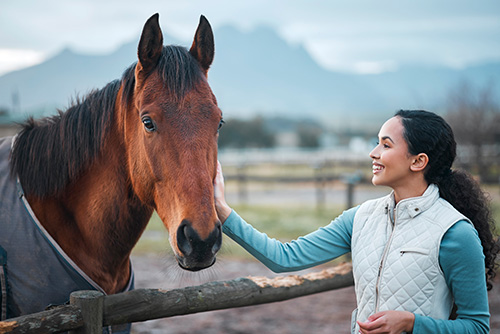Promoting Fall Equine Preventive Care
By Dr. Cathy Barnette, a paid Consultant for Covetrus®
After the warm summer months have passed, clients’ thoughts often turn from infectious diseases to other matters. As they shift their focus to securing hay and ensuring that they have enough water trough heaters, vaccinations may be the farthest thing from your clients’ mind.
Unfortunately, cooler temperatures may not eliminate the threat of infectious disease. Depending on your geographic location and your patients’ individual risk factors, vaccine boosters in September or October can play an important role in protecting your equine patients.

Core Vaccines
Eastern Equine Encephalitis (EEE) virus and Western Equine Encephalitis (WEE) virus are transmitted by a variety of different mosquito species.1 Most mosquito species become inactive in temperatures below 50 - 60°F, leading many of us to regard EEE and WEE as spring and summer diseases. However, in many areas of the United States, daytime temperatures in the fall and early winter do not remain consistently below this temperature threshold. If you practice in one of these areas, your patient’s risk of EEE and WEE does not end as soon as the leaves begin to change color.
Although commercially-available West Nile Virus vaccines have been shown provide one-year duration of immunity,2 the duration of immunity for EEE and WEE vaccines has not been established.3 Therefore, in areas where mosquito populations persist for more than six months out of the year, twice-yearly vaccination is recommended to ensure continuous immunity. Fall boosters are especially important for horses with a weakened immune system, which can be caused by conditions such as unregulated Cushing’s disease.
The American Association of Equine Practitioners (AAEP) vaccine guidelines underscore the potential need for fall EEE/WEE boosters, stating, “In animals of high risk or with limited immunity, more frequent vaccination or appropriately timed vaccination is recommended in order to induce protective immunity during periods of likely exposure.”4 If your area has the potential for warm weather in fall and winter, work with clients to perform an individual risk assessment for each of your patients.
Risk-Based Vaccines
Viral respiratory infections, such as equine influenza (EIV) and equine herpesviruses-1 and -4 (EHV-1/4), can be spread just as easily during the winter months as during the summer months. However, vaccines against these respiratory infections typically have only a 6-month duration of immunity.5
As the summer show season calms down and horses are not regularly traveling to competitions, horse owners may place less emphasis on maintaining EIV and EHV-1/4 vaccines. However, it is important to discuss all potential risk factors with your clients. Even if your patient does not travel during the fall and winter months, being housed in a barn where other horses travel may mean that fall vaccine boosters are indicated.
Summary
Vaccines and wellness care are often at the top of owners’ minds in the spring, when mosquitoes are emerging and horses are more likely to travel for pleasure or competition. Depending on the specific horse and your geographic location, however, fall vaccine boosters may be just as important for your patients.
Reach out to your equine clients proactively, encouraging them to consider their horse’s fall vaccination needs. Covetrus® Care Plans can support you in this endeavor, helping your clients budget for twice-yearly veterinary exam. Each exam provides you with an opportunity to perform an individual patient risk assessment, while also educating your client on other aspects of preventive care.
About the author Cathy Barnette, DVM is a veterinarian and freelance writer, based in Southwest Florida. After graduating from the University of Florida in 2006, Dr. Barnette spent 14 years working in small animal general practice. Her current professional focus is veterinary writing, creating educational content for veterinary teams and their clients. Dr. Barnette is a paid Consultant for Covetrus®.
1. Centers for Disease Control. Eastern Equine Encephalitis Virus: Transmission. Retrieved from: https://www.cdc.gov/easternequineencephalitis/transmission/index.html
2. American Association of Equine Practitioners. West Nile Virus. Retrieved from: https://aaep.org/guidelines/vaccination-guidelines/core-vaccination-guidelines/west-nile-virus
3. World Organization for Animal Health. (2018). Equine Encephalomyelitis (Eastern and Western). In Manual of Diagnostic Tests and Vaccines for Terrestrial Mammals (p. 1285). Retrieved from: https://www.woah.org/fileadmin/Home/fr/Health_standards/tahm/3.05.05_ EQUINE_ENCEPH.pdf
4. American Association of Equine Practitioners. Eastern & Western Equine Encephalomyelitis. https://aaep.org/guidelines/vaccination-guidelines/core-vaccinationguidelines/easternwestern-equine-encephalomyelitis
5. Davis, E. Fall Vaccines for Your Horse. Retrieved from: https://aaep.org/horsehealth/fall-vaccines-your-horse
Careers
Are you looking for a place to let your talents shine? At Covetrus, we help our practitioner customers better serve their patients and take pride in providing the best customer experience possible. Search our open positions to see our available opportunities.
Newsletter
Stay current with what’s going on with Covetrus, subscribe to receive our newsletter and email communications. Subscribers will receive the latest information in practice management, sales and marketing, animal health, and more.


Leave a comment